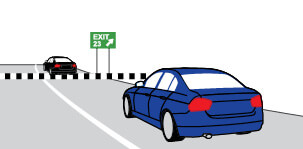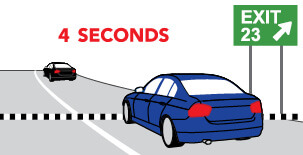6- Looking Ahead
Goal: Teach your teen to develop defensive driving techniques and higher-level visual and anticipatory driving skills before moving on to more complex driving situations. In order to avoid last-second reactions and spot potential hazards, have your teen always look 12–15 seconds down the road. When they are looking far enough ahead, they will be able to spot hazards early and be well prepared to react to them.
Location: Start on a quiet neighborhood street. Please do not use DMV skills test routes for practice. Move onto a road with light traffic when your teen is ready.
Lesson one – Zone Control System
Teach your teen the Zone Control System, a simple system to help new drivers recognize, anticipate
and avoid risks before they turn into problems.
ABCs of Zone Control:
- Find a LOS-POT (line of sight-path of travel) zone change
- Check other zones
- Select the best choice of speed, lane positioning, communication
Have your teen use commentary driving as they practice the Zone Control System. As they drive, ask them to verbally describe their thoughts, intentions, and actions in order to identify potential risks they see in their line of sight or path of travel. Check the options available for speed, lane position, and communication and make the safest adjustment.
Lesson two – stopping-distance rule

Source: Professor Fred Mottola, Executive Director National Institute for Driver Behavior
Teach your teen the stopping-distance rule, for the safest distance to stop behind another vehicle. When your vehicle stops, you should be far enough away from the car in front of you that you can see where its tires make contact with the ground. Any closer is too close.
Lesson three – four-second rule
Teach your teen the four-second rule for the appropriate following distance when driving behind other vehicles. The four-second rule is an important safety measure designed to give drivers enough time to safely steer or brake to avoid problems that occur in front of them on the road.
- Start counting when the rear bumper of the vehicle in front of you passes a fixed object like a sign or telephone pole.
- Count “one thousand ONE, one thousand TWO, one thousand THREE, one thousand FOUR.”
- Your front bumper should not pass that fixed object before you’ve reached “four.”
Have your teen practice the four-second rule at least 10–12 times, counting out loud to check whether their following distance is appropriate. If the road is wet, add on an additional second. If you drive an SUV or heavier vehicle, add an additional 1-2 seconds, as it will take your car longer to stop. Always err on the side of caution and allow for more space in front of you.


Your front bumper should not pass before you’ve reached “four.”